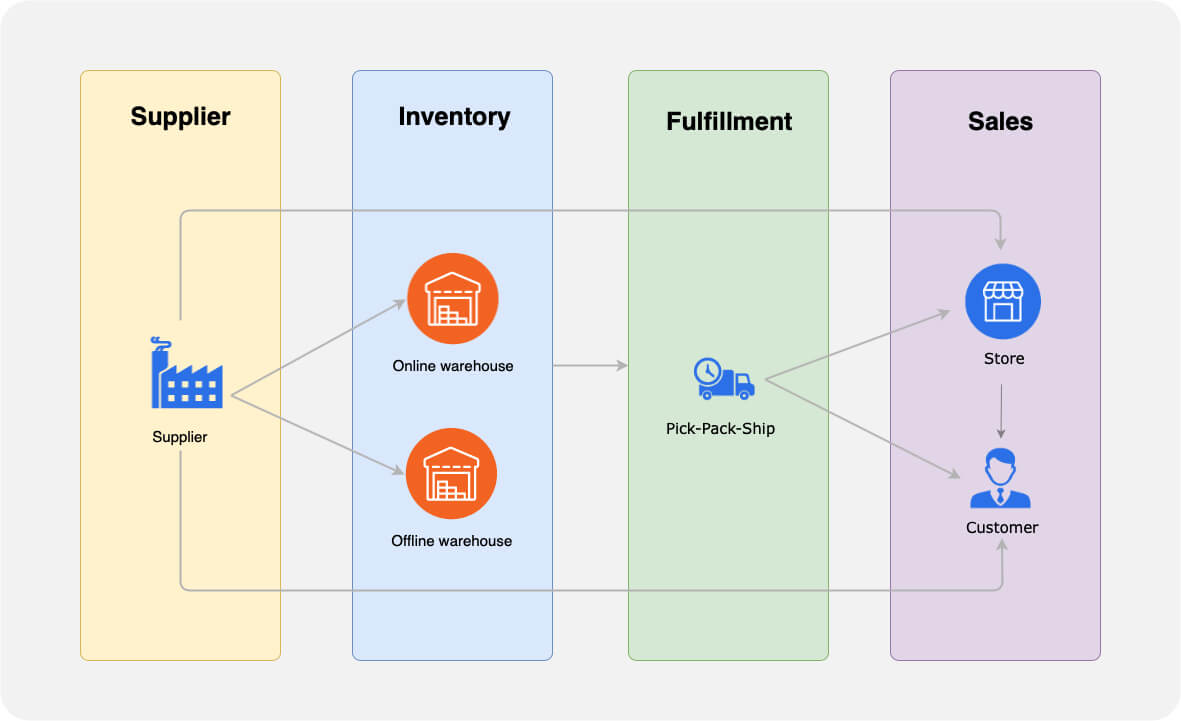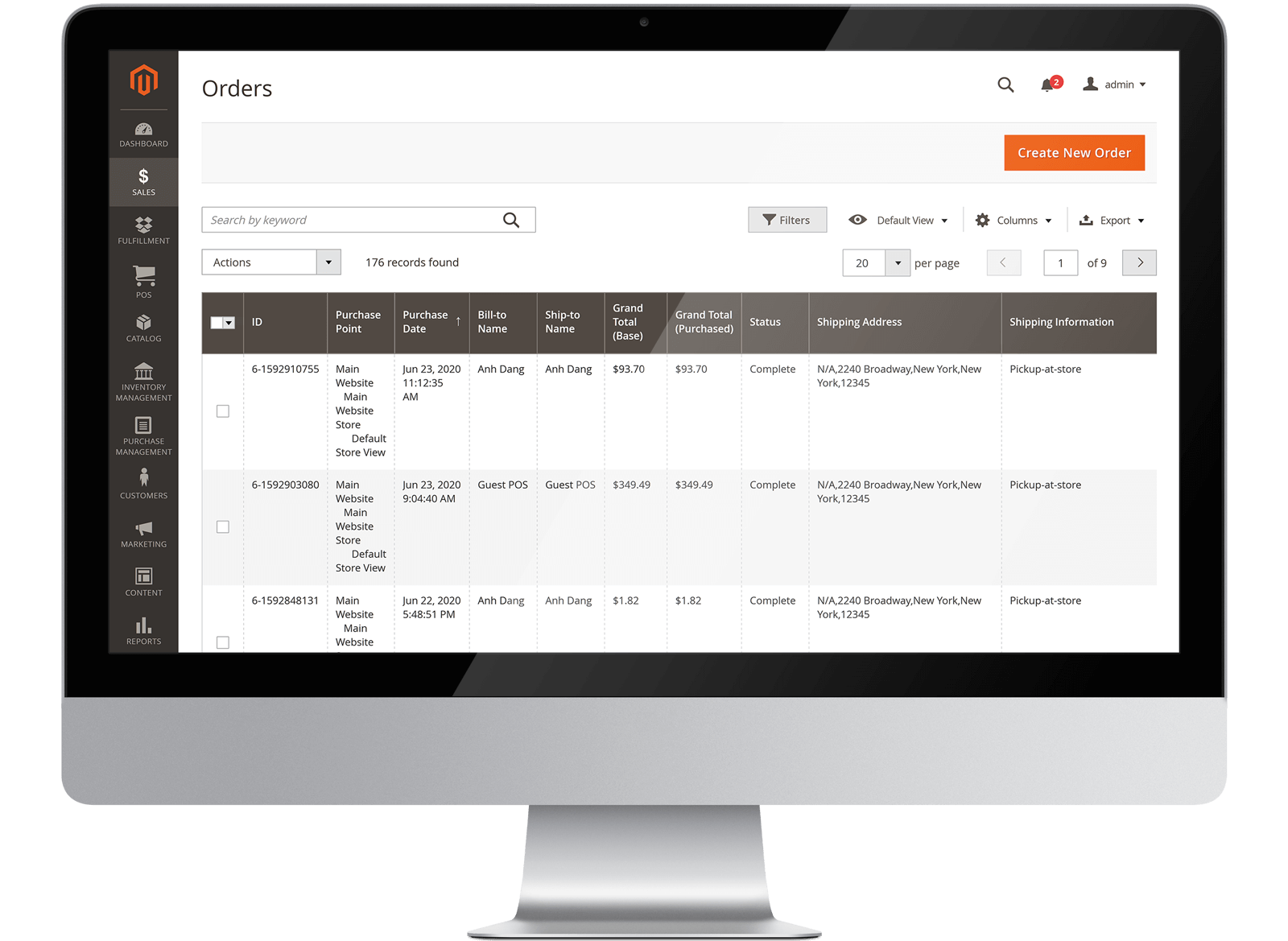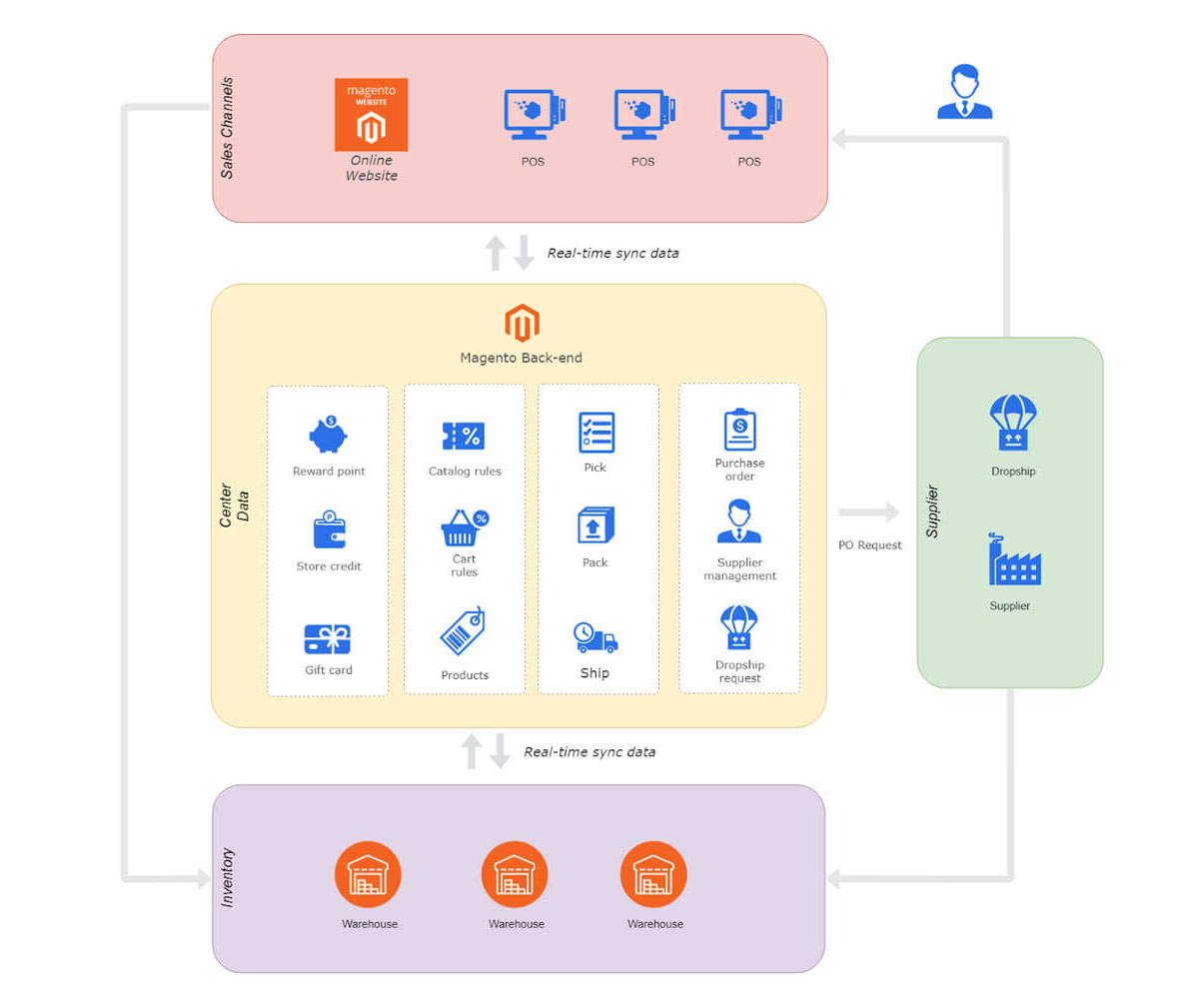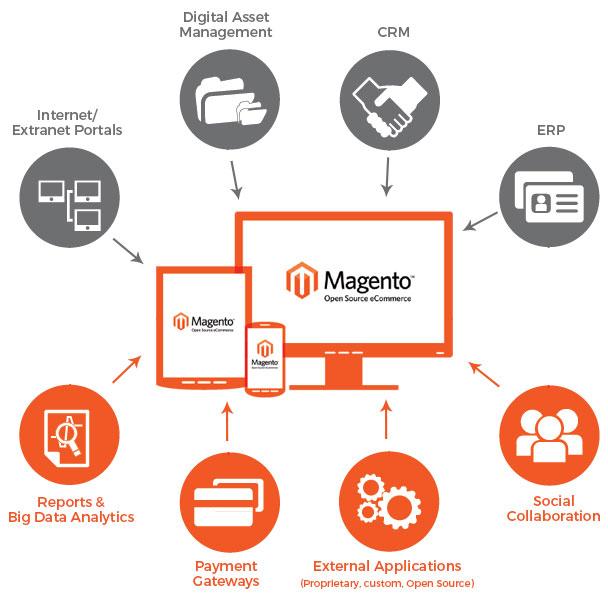Chapter 3: Manage data centrally in Magento omnichannel retail
Many retailers using Magento struggle with managing information systems and related databases. A primary reason is the lack of centralization. They want to turn Magento into a powerful centralized system but don’t know what Magento is capable of and how to start. This chapter will dig deeper into how omnichannel business works in terms of “data.” It will also explain how to take advantage of Magento plus its worldwide network to build your own centralized data system.
What exactly is data centralization in Magento?
”At the heart of all omnichannel customer engagement solutions is the data that drives it.
omNovos, Data Drives Omnichannel Success Whitepaper

The importance of data centralization
Today an omnichannel retailing strategy is crucial for all growing Magento merchants. Magento retailers need open lines of communication across multiple channels such as in-store, online, mobile device, or social media. These lines lead to a continuous and seamless experience across brands and devices.
To engage with customer one-on-one and make omnichannel initiatives a reality, retailers must connect myriad systems and databases. These include Magento eCommerce platforms, Magento-native/integrated POS (point of sale) systems, ERP systems, customer relationship, and marketing automation management tools. To succeed in the new omnichannel world, it is critical that Magento retailers create a fully integrated solution connecting every aspect of their data and its associated parts. We call it a centralized data management system.
With centralized data management in Magento, data is always up to date and accessible to your retail. This allows anyone to update information that is vital to your company and also to your customers.
Also, the cons of a decentralized system will give you more reasons to make the switch to an integrated data management platform. We all know that decentralized businesses handle their data in silos which is a pain. Breaking down these silos and connecting engagement technology at the data layer is the first step in the journey towards effective omnichannel retailing. It also often leads to data taking a more central role in decision making.
In this chapter, we only focus on how to utilize the Open Source version of Magento and its community to build a centralized data management system.
What kinds of master data do retailers need to centralize?
To build your own omnichannel structure, you need to connect all the main data in your daily operation — which is often called master data — in one centralized system. But what key data do you need to centralize for the purpose of going omnichannel? Let’s find out what they are in each business flow in a typical supply chain:

Supply chain model
Sales activities
Omnichannel in sales activities allows shoppers to buy seamlessly via all sales channels and still keeps them engaged. Also, their purchasing history will update to the right data. In detail, before making any purchases, customers move between channels to browse products, compare sales prices, and check the available quantity. After purchasing, they can check the list of ordered items and the paid amount from just a single view.

Customers checking sales orders via mobile
To do that, retailers should store all data from brick-and-mortar and online stores centrally and accessibly. The most common data for sharing between channels include:
- Master data: Product name, category name, manufacturer, description, image, sales price, other attributes, salable quantity
- Transactional data: Online sales orders, offline sales orders, invoices, credit memos, shipment
Procurement
Procurement is the process of getting the goods and/or services your company needs to fulfill its business model. To achieve omnichannel, retailers need to consider a fully integrated procurement operation to other aspects such as inventory, sales, and fulfillment. Through this way, data from the procurement process will be the inputs for other related activities.

Procurement operation
For example, based on the sales order’s incoming quantity and lead time, the merchant can prepare fulfillment and update product information to customers. When the purchasing staff creates the orders for out-of-stock products, these products will show the expected arrival date as well as Arriving soon status on the website and point of sale screen. This status will also be updated if the staff processes orders.
To ensure the process run smoothly like above, retailers should put a lot of effort into a data centralized system. The key data in this flow includes:
- Master data: Product name, cost (price list), discount, incoming quantity, quantity received
- Transactional data: Purchased order, good receipt, payable account
Order fulfillment
Order fulfillment is the whole process from the time the customer orders to when the merchandise deliveries items to the end-user. It includes pickup, warehousing, packaging, and delivery to the buyer on time.

Inventory visibility in retail
Key data to manage this process includes:
- Master data: Product name, quantity picked, quantity packed, quantity shipped, fulfillment status, distance and delivery time
- Transactional data: Picking slip, packing slip, shipping slip
All these consistent data contribute to making omnichannel happen. For example, customers can check the fulfillment status of a sales order from their view. Also, salesman can easily answer all customer’s questions relating to order fulfillment.
Inventory & Warehouse Management
Inventory management plays an important role in an omnichannel operation. There’re many benefits when you transform your current system into a centralized inventory management system in place for all the channels you sell on:
- Make customers happier
- Increase your ROI
- And just make your retail run all-around easier as your business scales
By adopting omnichannel, you can manage and synchronize all of your business’ inventory from a single-view inventory system across all the channels you sell it on. They include physical stores, eCommerce websites, mobile popups, marketplaces and even social media platforms like Facebook; also all warehouses you store your products.

Inventory visibility in retail
The system helps you sell your products and services to the widest consumer base possible by simultaneously providing customers with information on the availability and delivery times of products in all channels. Customers then have an opportunity to choose the channel to purchase from, online or offline.
Regarding the internal process, this centralized inventory management system can accelerate fulfillment, prevent overselling, and eliminate countless hours of manual data entry.
To ensure the system runs without any hassles, retailers should pay attention to the following data and track them correctly:
- Master data: Warehouse, product information, quantity on-hand
- Transactional data: Quantity in shipping orders
The result will give the retailer a whole vision about the crucial stock information, such as quantity in the warehouse, product quantity in shipping, quantity in stock, quantity sold, etc. Also, the product quantity can show correctly on all sales channels that are connected with the centralized data system.
Loyalty & Customer management
Consistency is a key component of omnichannel loyalty programs. To do that, you need to centralize your customer profile data along with loyalty records and sync them across sales channels. The result is that salesmen can access the customer’s loyalty/ history information to offer better consultation. Salesmen can be more active in working and spend less time searching. Besides, by storing all the information about your customers in a centralized system, businesses can learn about the latest trends in consumer behavior.
Customers can also engage seamlessly with your brand on a variety of platforms, devices, and channels with the best shopping experience.

Customer and loyalty management needs to centralize
To build an omnichannel customer loyalty system, you need to focus on these key data and make sure they’re available and accurately tracked in an all-in-one system:
- Master data: Customer information, customer’s reward points, product reviews, and information sharing.
- Transactional data: Products purchased, prices paid, customer transactions, coupon or other discount offer used.
Customer and loyalty data need to be centralized and synchronized across sales channels to deliver a meaningful experience. Retailers can use the above data to personalize recommendations and offers, streamline purchasing process, and offer instant access on different devices. Retailers should be ready to adapt and innovate their programs on a regular basis.
Is Magento Open Source ready for data centralization?
To perform data centralization and achieve omnichannel on Magento, retailers should be aware of Magento capacity. This section will shed light on the strengths and weaknesses of Magento in implementing data centralization system to:
- Sales activities
- Procurement
- Order fulfillment
- Inventory & warehouse management
- Loyalty & customer management
Sales activities data centralization in Magento
Synchronize sales data across multiple sales channels
- Multiple channels: Magento is a strong platform in terms of multiple websites with three layers which are websites, store, and store view. This is the reason why Magento is one of the best choices for retailers who want to develop professional eCommerce sites in the long term.
With more than 200,000 users, Magento Open Source Edition is one of the most popular open-source eCommerce platforms available.
Source: www.ecommerceceo.com
With the latest updates, Magento allows merchants to set up separate sites for different currencies in different languages, and still ensure that they’re all managed from the same Admin Dashboard.
Magento also provides Amazon Sales Channel, a free and downloadable extension, to integrate retailer’s Amazon selling account with Magento. Now retailers can update product catalog between Magento and Amazon, and seamlessly manage their Amazon sales from Magento. It not only empowers retailers to reach customers but also prevents data silos.
- Product data and sales transaction
- Product data: Master product data such as name, description, image, sales price, product types are completely available in the Magento 2.3 by default and referred to as System Attributes. Moreover, merchants can create as many attributes and attribute sets as necessary, to describe specific characteristics of a product in their catalogs.
- Sales transaction: Magento core stores all transactional data such as sales orders, invoices, credit memos, or payment transaction. The platform keeps the transactions from different websites in one central hub, where admin can quickly process them.

Sales order grid in Magento
What Magento needs to improve
The core Magento Open Source does not support offline channels such as point of sale or social media channels. Thus, if you expect to expand your sales channel, you’ll need third parties for an integrated solution. Otherwise, there’ll be data silos between online and offline channels.
Procurement data centralization in Magento
To get data centralization for omnichannel strategy, it requires key data, namely, supplier, price list, purchase order, or the payable account from the procurement process. However, Magento Open Source does not support the procurement currently.
Fulfillment data centralization in Magento
In terms of order fulfillment, Magento does not cover this feature in Open Source edition. It’s unattainable for the merchant to handle fulfillment via Magento admin with just the Magento core. In such a way, buy online ship from suppliers, or buy at store ship to home, also become more challenging for merchants. However, you can find many other solutions among Magento community to fill all the gaps.
Inventory & Warehouse data centralization in Magento
Synchronize inventory data across online websites
Before releasing the Magento Open Source 2.3 version, Magento manages a single inventory system. Due to this, it’s really hard to manage multichannel inventory from a single website. It seems like Magento’s recognized this weakness and improves it in the 2.3 version with Multiple Source Inventory (MSI).
With this feature, you can manage inventory data with different warehouse locations, product types, or sources across eCommerce channels. On top of that, MSI also supports auto shipping items from multiple sources to complete orders based on balanced inventory, shipping cost, etc.
Synchronize inventory data to Marketplace
There’s also Amazon Integration (a free downloadable extension), which synchronizes your product catalog from Magento to your Amazon selling account based on the technology of integrating the two systems. Retailers can manage product types and information centrally and they will visible in both Magento websites and the Amazon Marketplace. Not only this empowers retailers to reach more customers but also keeps them out of data silos.
What Magento’s still missing
With inventory and warehouse management system from Magento, you can store and sync inventory data between website channels. Though it’s not a complete omnichannel system, it’s still a good foundation to help you go omnichannel easier.
For example, if you have offline channels, you can link MSI to your POS at each store to sync product from online to offline. For fulfillment, inventory visibility will help perform pick-pack-ship process in real-time. For purchases, you can use the inventory and sales data to calculate how much you need to replenish.
Loyalty and Customer management data centralization in Magento
What Magento is doing well
Loyalty and customer management are also one of Magento’s big advantages over other platforms, especially in terms of synchronizing customer’s reward history across online channels.
The system in Open Source version already supports customer management and discount/promotion (catalog rules, cart rules) across all online channels (multiple websites). Thanks to the latest updates, Magento system can create additional attributes to customer profile for personalization/promotion purposes.
What Magento is missing
The Magento system still lacks some advanced reward programs such as store credits, reward points, membership, gift card. So it couldn’t store and collect the data to analyze customer behaviors or customer reward history.
How to manage data centrally in Magento omnichannel retail?
Once you know about the capacity of Magento, you can now take actions to solve the gaps that Magento doesn’t support. We suggest the following two solutions that can help you achieve a complete omnichannel solution: Magento-native omnichannel solution and integrated omnichannel solution.
Magento-native omnichannel solution
Not every platform is a perfect fit for your business. But Magento has a large community to support them and fill the gap of lacking data, function, or features. There are plenty of Magento-native solution providers, partners of Magento on the market that you can find.
These solutions develops basically right on the core Magento platform so you just need to install, or implement directly on Magento source code. The UI/UX is also familiar with Magento users which is a big advantage.
Take Magestore omnichannel solution as an example:

Magestore solution architecture
Magestore provides a complete omnichannel solution that is native to your Magento websites. By using a complete Magento-native solution, it means all the essential added features is developed right on the Magento core. You can avoid errors in your omnichannel system as everything is perfectly developed and tested.
If you use many extensions/products from different providers, it might conflict with each other which is not a good thing for the long run. Besides, the solution from Magestore supports what Magento core (Open Source version) doesn’t have, such as order fulfillment, advanced inventory management, offline channels, etc. Magestore POS also seamlessly integrates with a wide range of payment processors, like Stripe, Square, Adyen, Dojo, and more, providing a seamless omnichannel payment experience across all channels.
This doesn’t mean you can only choose only Magento-native solution for your omnichannel approach. You can combine this kind of solution to one or many integrated omnichannel solutions. Keep reading to the next solution as below.
>>> Might you like: Full-featured omnichannel Magestore Stripe Point of Sale.
Integrated omnichannel solution
In addition to using Magento-native solution, merchants could approach an integrated solution to turn Magento into an all-in-one system. Magento system connects to third parties via Magento Web API (Application Program Interface). By integrating these systems, key data for omnichannel will be synchronized at a certain time depending on the configuration.
Merchants can store all data in Magento backend and use them as inputs for other operations in omnichannel retail.

Integrated omnichannel solution
Let’s look at the following example:
A retailer runs his business via multiple Magento websites, seller account on eBay & Amazon, and offline stores. He also provides a self-service kiosk machine in offline store. The merchant integrated his Magento site to the self-service kiosk machine, loyalty app, Stripe terminal device, but still ensure the consistent data flows across the whole system.
His customers could check out order, pay with Stripe and scan QR code from loyalty application to earn reward points by themselves. The loyalty app informs updated point balance according to the transaction. All these seamless experiences are supported by a centralized system with out-of-the-box features.
Above is just one example of how a retailer can go omnichannel with an integrated system that centralizes data.
If you’re looking for a complete solution, you can implement the integration through the following options:
- Option 1: Reach third-parties providing available solutions on Magento
- Option 2: Take advantage of ready-to-use connectors in marketplace.magento.com
- Option 3: Utilize in-house developers
- Option 4: Use integrating services from agencies
Pros and Cons between Magento-native and Integrated solution
Here is a summary of the pros and cons of implementing a centralized system by Magento-native against integrated solution.
| Magento-native solution | Integrated Solution | |
|---|---|---|
| Pros |
|
|
| Cons |
|
|
| Magento-native solution |
Pros:
|
Cons:
|
| Integrated solution |
Pros:
|
Cons:
|
Depending on the needs and capabilities, retailers can choose the best way to deploy a centralized data system. It is not compulsory for businesses to choose only one of them, it’s possible to combine both ways to achieve the goal quickly and efficiently.
To sum up
This chapter covers everything you need to know about data centralization – the heart of omnichannel system, and more importantly how data centralizes in Magento platform.
The importance of acknowledging Magento capacity (what they’ve done well, what they need help from the ecosystem) will support you utilize Magento core at its full potential; also, look for the right solutions to meet your business’ requirement if you can’t find what you need in Magento Open Source version.
Continue Reading
Previous Chapter
Omnichannel Model and Roadmap
Next Chapter
Omnichannel Experience on Magento







